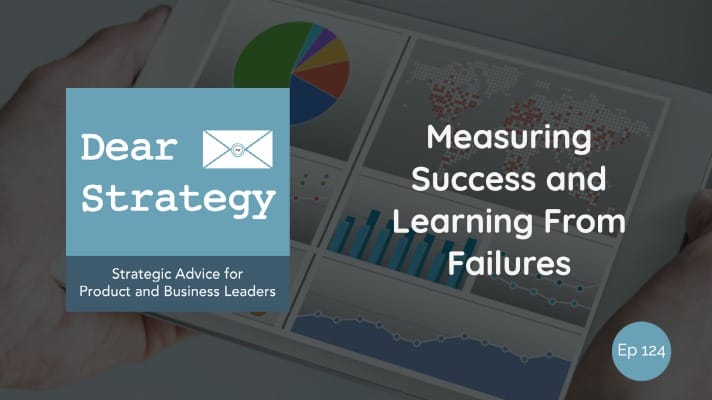On this episode of Dear Strategy, we answer the following question…
Dear Strategy:
“How can we measure the success of our strategy using some KPI other than orders? How do we learn from our failures?”
Before I answer the second part of this question. I need to address the definition that was referenced in the first. So what exactly is a KPI, and how does it differ from all the other types of measurements that are thrown about in the field of strategic planning? That’s the meat of what I want to answer for you here today. But not without first giving a quick disclaimer that, like most of the terms, titles, and acronyms that are used throughout the world of business planning, the ones I’m going to be discussing in this post can be highly variable depending on which book you’re reading, which professor you’re listening to, or which consultant you happened to have hired. So what I’ll attempt to do here is present you with the most widely accepted definitions that I know of, while also trying to clear up some of the most common misconceptions that I typically come across.
So, let’s start at the top. Every strategy needs to have some component of what you are trying to achieve. And that component will typically be broken down into several different layers as follows:
Vision – This is the highest-level statement of what you want your strategy to help you achieve. The timeframe for your vision is usually 5-10 years out (or more), and the format is typically very high-level and very aspirational.
Example:
My vision is to live in a world without cancer.
Goals – Your goals should represent milestones that you want to achieve on your way to attaining your vision. Like a vision, goals are typically stated in fairly broad terms (i.e. without a measurable component). But, unlike a vision, your goals should represent definitive milestones that you actually plan to achieve. In this way, your vision becomes a final destination that you aspire to reach, whereas your goals become actual achievable milestones that you intend to accomplish along the way.
Example:
I want to earn a PhD in Molecular Biology
Objectives – Your objectives are designed to take your goals and break them down into measurable components that can be tracked in relation to your strategy. Taken literally, your objectives can be thought of as the “objects” of your goals (a definition which will become important later in our discussion). If you’ve heard of the SMART principle (Specific, Measurable, Assignable, Realistic, Time-realted), this is the level at which that particular acronym should apply.
Examples:
I want to achieve my PhD from a specific school by a specific date.
I want to contribute to at least 2 peer-reviewed research papers within 5 years.
Projected Results – The last layer of strategic accomplishment comes in the form of projected results. This layer takes your objectives, and breaks them down into actual measurements that you can track every year. This allows you to turn your objectives into a dashboard that can be tracked on a monthly, quarterly, or annual basis.
Examples:
Year 1 – Get Accepted to School X
Year 3 – 1st Peer Reviewed Paper Published
Year 5 – 2nd Peer Reviewed Paper Published
Year 6 – Receive PhD with Distinction
With all of those definitions, then, where in the world does this term “KPI” fit in?
KPI stands for “Key Performance Indicator,” and it effectively refers to any metric that you deem as being strategically important to your business. As an example, if I am running a restaurant, I may decide that revenue per month, profit margin per month, number of take-out orders per day, number of dine-in customers per day, and number of customer complaints are all measurements that are critical to the success of to my business. These would then all become KPIs that I choose to track.
So is a KPI simply a metric or is it an actual threshold of what you want to achieve? The answer is that it can be both. Some schools of thought use the term KPI to represent how you want to measure your business. Others will extend the term to include the actual numbers that you want to achieve within each measurement. To my taste, I tend toward the first definition where a KPI is simply a metric, and the result you want to achieve is stated as your objective. In that way, the KPIs remain more or less constant as a way to measure your business, while your objectives around those measurements can vary with respect to whatever strategy you’re trying to carry out.
“Some schools of thought use the term KPI to represent how you want to measure your business. Others will extend the term to include the actual numbers that you want to achieve within each measurement.”
Now, before I move on to actually answering the question, there is one more theory that’s worth mentioning – and that is the OKR framework, which is short for “Objectives and Key Results.” This is a framework that’s been around for quite some time, but that also seems to have gained a lot of recent traction in the tech and software spaces. The general idea of OKR is exactly the same as the framework that I presented above. However, the definitions, for whatever reason, seem not to be quite as aligned with traditional strategic practices. For example, in the OKR theory, the term “Objectives” is used to signify the higher-level, broader components of what you want to achieve (similar to what are referred to as “Goals” in more tradition strategic circles), while the “Key Results” are used to signify the measurable components of what you intend to achieve (similar to what I referred to as “Objectives” above). Again, the theory is more or less the same, but the definitions just don’t seem to fit quite as nicely with what I believe to be the true meanings of the terms that are being used. In my mind, objectives should be, well, objective! That is, they should be quantifiable and able to be backed up with real data. And key results should be what you actually achieve rather than what you intend to achieve – the latter of which I believe is more accurately referred to as “projected results.” In any case, semantics aside, the framework is fairly well-adopted and, at its core, isn’t much different than the one that I discussed above. So it’s all good in my book.
So, with all of those definitions finally out of the way, now I can get around to actually answering the question! And the good news is that I kind of already have. The whole point of adopting one of these frameworks is to tie your strategy back to the more granular results that you are hoping to achieve. So if “orders” has been chosen as a KPI without regard for what your actual strategy is, then you need to go back to your strategy, look at your objectives, and translate them into a set of additional key measurements that are strategically important to your business. Then, if you fail to achieve the results that you projected, rather than scurrying about trying to get more orders, you’ll be able to go back to the strategic initiatives that were designed to help impact your metrics and address those instead. That’s also how you’ll be able to learn from your failures – by understanding what initiatives weren’t working in the first place, and then working to correct them at their core. And you can only do all of that if your measurements are linked back to some sort of an overarching strategic plan.
So, as is often the case, the short answer is that you need to have a strategy! Then your metrics will practically be able to write themselves.
Listen to the podcast episode
Dear Strategy: Episode 124

Are you interested in strategy workshops for your product managers or business leaders? If so, please be sure to visit Strategy Generation Company by clicking the link below:
 Bob Caporale is the founder of Strategy Generation Company, the author of Creative Strategy Generation and the host of the Dear Strategy podcast. You can learn more about his work by visiting bobcaporale.com.
Bob Caporale is the founder of Strategy Generation Company, the author of Creative Strategy Generation and the host of the Dear Strategy podcast. You can learn more about his work by visiting bobcaporale.com.






